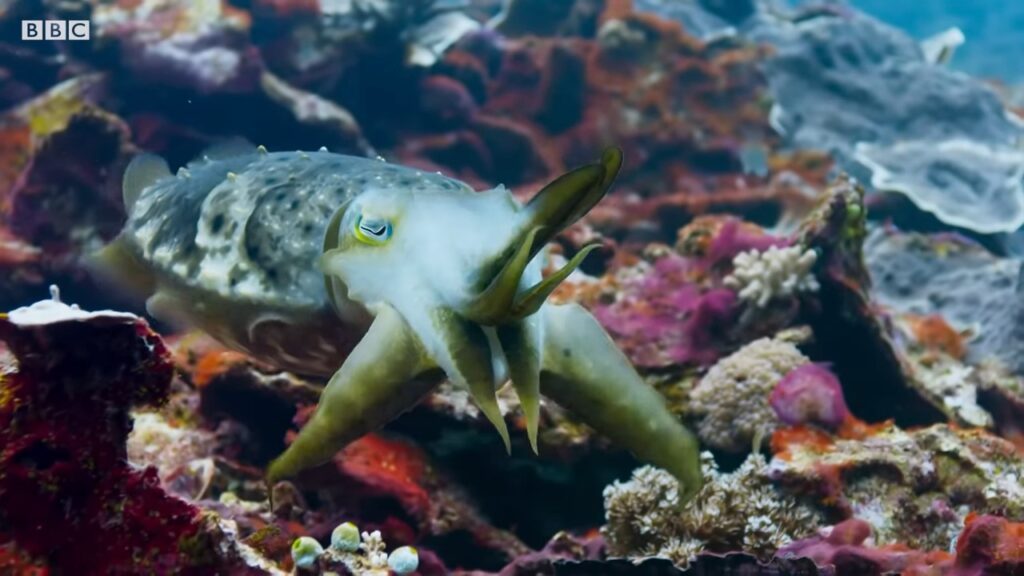In the video, a large cuttlefish floats near the ocean surface, ejecting dark ink clouds as a fisherman attempts to scoop it with a long-handled net. The cephalopod releases ink in precise bursts—a survival tactic evolved over 200 million years.
Ink and Shadow: A Giant Cuttlefish’s Desperate Fight for Freedom
The ocean floor is a realm of silent, ancient dramas. It’s a stage where light, color, and pressure play the leading roles, and its actors are some of the most alien and intelligent creatures on our planet. Among them, the Giant Australian Cuttlefish stands as a true marvel—a master of disguise, a sentient tapestry of shimmering skin. But even a master of illusion can be caught off guard by a threat it cannot comprehend.
This is the story of a standoff, not between predator and prey, but between ancient instinct and an unthinking, modern menace: a fishing net.
The Living Canvas
Imagine our protagonist: a large male cuttlefish, nearly a meter long, hovering just above a rocky reef. His body is a living canvas, controlled by a mind of profound complexity. His skin flickers with waves of hypnotic, pulsing light—a display of dominance and health. One moment, he is the exact texture and color of the mottled, algae-covered rock beneath him. The next, as a small fish darts by, his skin flashes with iridescent blues and greens in a predatory shimmer.
This is his world. He understands its rhythms, its dangers, its opportunities. He can outwit sharks, mesmerize crabs, and communicate with his own kind through a language written in color. He is a king in his domain, armed with three hearts, blue blood, and one of the most sophisticated brains of any invertebrate.

The Creeping Geometry
The threat, when it comes, is silent and strange. It’s not a predator with teeth and eyes. It’s a shadow that moves with the current, a ghostly latticework of crisscrossing lines. A ghost net, torn from a trawler and left to wander the ocean, an indiscriminate trap.
To the cuttlefish, it is an anomaly. An unnatural geometry in a world of curves and chaos. His curiosity, a hallmark of his intelligence, might even draw him closer. He pulses his colors, trying to understand it, perhaps even trying to communicate with it. The net, of course, does not respond. It simply drifts, a patient, mindless hunter.
The current shifts. The standoff becomes an ambush. Before the cuttlefish can react, the fine, strong mesh envelops him.

The Trap is Sprung
Panic.
His first instinct is camouflage. He flattens himself, trying to become one with the net’s pattern, but the rough, synthetic material is alien. It offers no purchase for his illusion. His chromatophores fire wildly, a chaotic explosion of color that signals his terror.
He pushes against the walls of his prison, his powerful fins beating against the unyielding lines. He uses his jet propulsion, firing bursts of water to propel himself, but he only becomes more entangled. The net tightens. This foe has no face to intimidate, no body to trick. It is a puzzle with no solution, a physical law he cannot bend. For an animal whose survival depends on intellect and illusion, this is the ultimate nightmare.
The Ink Gambit
With options dwindling and energy fading, the cuttlefish turns to its most ancient and dramatic defense. It is a weapon of last resort, a desperate gambit played in the dark.
He draws in a final, deep surge of water. Then, with a powerful contraction of his muscles, he expels it all in one explosive burst. But this is not just water. It’s a thick, billowing cloud of sepia ink.
The ink is more than just a smokescreen. It’s a multi-layered weapon.
- The Visual Decoy: The cuttlefish expertly mixes the ink with mucus, shaping it into a phantom of his own size and shape—a “pseudo-morph.” This dark ghost hangs in the water, a perfect decoy to momentarily confuse a predator. While the net has no eyes, this act is pure, ingrained instinct.
- The Sensory Overload: The ink contains tyrosinase, a chemical that irritates a predator’s eyes and temporarily dulls its sense of smell. It’s a chemical “get away!” screamed into the silent water.
- The Ultimate Cover: Most importantly, the cloud creates chaos. It is a moment of pure, opaque blackness in the clear water. A void where sight is useless.
And in that void, the cuttlefish performs its final, brilliant trick.
As the dark cloud envelops the net, the cuttlefish instantly bleaches its own skin, turning a ghostly, translucent white. Under the cover of its own darkness, it becomes a phantom. With one last, desperate jet of water, it shoots backward, squeezing through a loose fold in the net it couldn’t see just moments before.
The ink cloud drifts and dissipates, revealing an empty net. The ghost has vanished. The real cuttlefish, now several meters away and already blending back into the reef, watches the soulless trap continue its silent, deadly journey.
He is shaken, but he is free. He has survived a standoff with a monster that had no mind, only a relentless, deadly design. It was a victory not of strength, but of brilliance, a testament to the incredible will to survive, written in a fleeting cloud of ink.